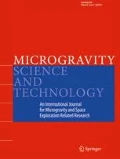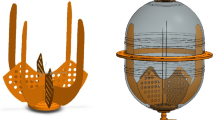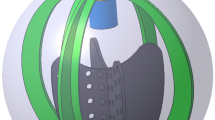Abstract
Fuel tanks are a core component in satellites that manage the propellant. This study numerically analyzed the fluid transport with parallel guide vanes in a vane type surface tension tank. Flow3D was used to simulate fluid transport in microgravity in a scale model with 15% liquid filling rate with comparisons to experimental data. Then, the simulations were used to compare the leading edge climbing speed for various working conditions and the liquid volume below a specified cross section for various liquid filling rates, various numbers of vanes. The results show that the liquid climbing process on the guide plate in the plate tank can be divided into the liquid level repositioning stage after the gravitational force is suddenly removed and the stable fluid transport stage. Throughout the entire capillary flow stage, the liquid leading edge climbing rate is not related to the filling rate of the number of vanes and the fluid transport efficiency of a single guide vane is independent of the total number of vanes.

















Similar content being viewed by others
References
Alexis, D., Mathieu, L., Sébastien, T.: Comparison between the FLUIDICS experiment and direct numerical simulations of fluid sloshing in spherical tanks under microgravity conditions. Microgravity Sci. Technol. 31(1), 123–138 (2019)
Baotang, Z., Yong, L., Hailin, P.: Experimental investigation on fluid-storage characteristic of propellant refillable reservoir in microgravity environment. Aerosp. Control Appl. 40, 27–30 (2014)
Brian L, Adrien B, Grace P.: A Comparison Investigation of Experimental and Computational Fuel Slosh Models Utilizing Diaphragm-Implemented Spacecraft Propellant Tanks. 53rd AIAA/ASME/ASCE/AHS/ASC Structures, Structural Dynamics and Materials Conference, 20th AI, AIAA 2012–1885, Hawaii (2012a)
Brian L, Adrien B, Sathya G. A.: Computational Investigation for Determining the Natural Frequencies and Damping Effects of Diaphragm-Implemented Spacecraft Propellant Tanks. 53rd AIAA/ASME/ASCE/AHS/ASC Structures, Structural Dynamics and Materials Conference, 20th AI, AIAA 2012–1886, Hawaii (2012b)
Collicott S.H., Weislogel M.: Modeling of the operation of the VTRE propellant management device. In 38th AIAA/SAE/ASME/ASEE joint propulsion conference, Indianapolis (2002)
Collicott S., Weislogel M.: Modeling of the operation of the VTRE propellant management device. AIAA/ASME/SAE/ASEE Joint Propulsion Conference & Exhibit, 559–567 (2013)
Daniel, A.B., Yongkang, C., Ben, S.: Compound capillary flows in complex containers: drop tower test results. Microgravity Sci. Technol. 22(4), 475–485 (2010)
Diana, G., Michael, E.D.: CFD simulation of capillary transport of liquid between parallel perforated plates using Flow3D. Microgravity Sci. Technol. 27(4), 261–271 (2015)
Dipprey N., Rotenberger S.: Orbital express propellant resupply servicing. AIAA/ASME/SAE/ASEE Joint Propulsion Conference and Exhibit (2013)
Dominick S., Tegart J.: Orbital test results of a vaned liquid acquisition device. AIAA, 94–3027 (1994)
Gabriel L, Daniel K, Hector G.: Results of microgravity fluid dynamics captured with the spheres–slosh experiment. 66th international Astronautical congress, Israel (2015a)
Gabriel L, Hector G, Daniel K.: Characterization of Elastomeric Diaphragm Motion within a Spacecraft Propellant Tank. 51st AIAA/SAE/ASEE Joint Propulsion Conference, The U.S (2015b)
Harry C, Christopher G. A, Jacqueline Y.: Development of 10 inch Diameter Titanium Rolling Metal Diaphragm Tank for Green Propellant. AIAA Propulsion and Energy Forum, 53rd AIAA/SAE/ASEE Joint Propulsion Conference, The U.S (2017)
Henry W.M, Joseph T.M, Caitlin E.B.: Green Propellant Loading Demonstration at U.S. Range. Propulsion and Energy Forum, 52nd AIAA/SAE/ASEE Joint Propulsion Conference, UT (2016)
Ideo M, Tadashi M, Kazuki M.: Development of New Composite Propellant Tank for Satellites. Propulsion and Energy Forum, 50th AIAA/ASME/SAE/ASEE Joint Propulsion Conference, The U.S (2014)
Jinghao, L., Xiaoqian, C., Yiyong, H.: The review of the interior corner flow research in microgravity. Procedia Eng. 31, 331–336 (2012)
Lei C, Jintao L, Xinrong L.: Numerical simulation of the vane type tank and system on-orbit refueling process. IOP Conf. Series: J. Phys.: Conf. Series 1074, 012060 (2018)
Meyer, M.L., Chato, D.J., Plachta, D.W.: Mastering cryogenic propellants. J. Aerosp. Eng. 26, 343–351 (2014)
Neil B., Russel B, Alex F.: Design and Manufacture of Composite Liquid Oxygen Propellant Tank for University Rocket. AIAA SPACE Forum, The U.S (2017)
Parallel Perforated Plates using flow3D. Microgravity Science and Technology, 27(4), 261–271(2015)
Qi H, Xianwu L.: Research on fluid transmission performance of propellant acquisition vane microgravity environment. Proceedings of the ASME-JSME-KSME 2015 joint fluids engineering conference, Korea (2015)
Qi H, Yong L, Hailin P.: Numerical analysis and experiment research on fluid orbital performance of vane type propellant management device. IOP Conf. Series: Mater. Sci. Eng. 72, 042042 (2015)
Qi, K., Li, D., Li, Z.: Thermocapillary convection experiment facility of an open cylindrical annuli for SJ-10 satellite. Microgravity Sci. Technol. 28(2), 123–132 (2016a)
Qi H, Yong L, Jintao L.: Research on liquid sloshing performance in vane type tank under microgravity. IOP Conf. Series: Mater. Sci. Eng. 129,012016 (2016b)
Shuoting, Z., Li, D., Qi, K.: Experimental research on Thermocapillary-buoyancy migration interaction of axisymmetric two drops by using digital holographic interferometry. Microgravity Sci. Technol. 30(3), 183–193 (2018)
Stange, M., Dreyer, M., Rath, H.J.: Capillary driven flow in circular cylindrical tubes. Phys. Fluids. 9, 2597–2601 (2003)
WenBo H, Xueye C.: Effect of Geometry Configuration on the Merged Droplet Formation in a Double T-Junction. Microgravity Science and Technology, pp 1–10 (2019)
Yongqiang, L., Mingzhu, H., Ling, L.: Study of capillary driven flow in an interior corner of Rounded Wall under microgravity. Microgravity Sci. Technol. 27(3), 193–205 (2015)
Yongqiang, L., Wenhui, C., Ling, L.: Numerical simulation of capillary flow in fan-shaped asymmetric interior corner under microgravity. Microgravity Sci. Technol. 29(1–2), 65–79 (2017)
Yuexing W.: Research on the Flow in the Process of the Propellant Management in a Spacecraft Tank under Microgravity. National University of Defense Technology, (2013)
Acknowledgements
This research was financially supported by the National Natural Science Foundation of China (Grant No. 51776017).
Author information
Authors and Affiliations
Corresponding author
Additional information
Publisher’s Note
Springer Nature remains neutral with regard to jurisdictional claims in published maps and institutional affiliations.
Rights and permissions
About this article
Cite this article
Zhuang, B., Li, Y., Liu, J. et al. Numerical Simulation of Fluid Transport along Parallel Vanes for Vane Type Propellant Tanks. Microgravity Sci. Technol. 32, 129–138 (2020). https://doi.org/10.1007/s12217-019-09746-2
Received:
Accepted:
Published:
Issue Date:
DOI: https://doi.org/10.1007/s12217-019-09746-2




